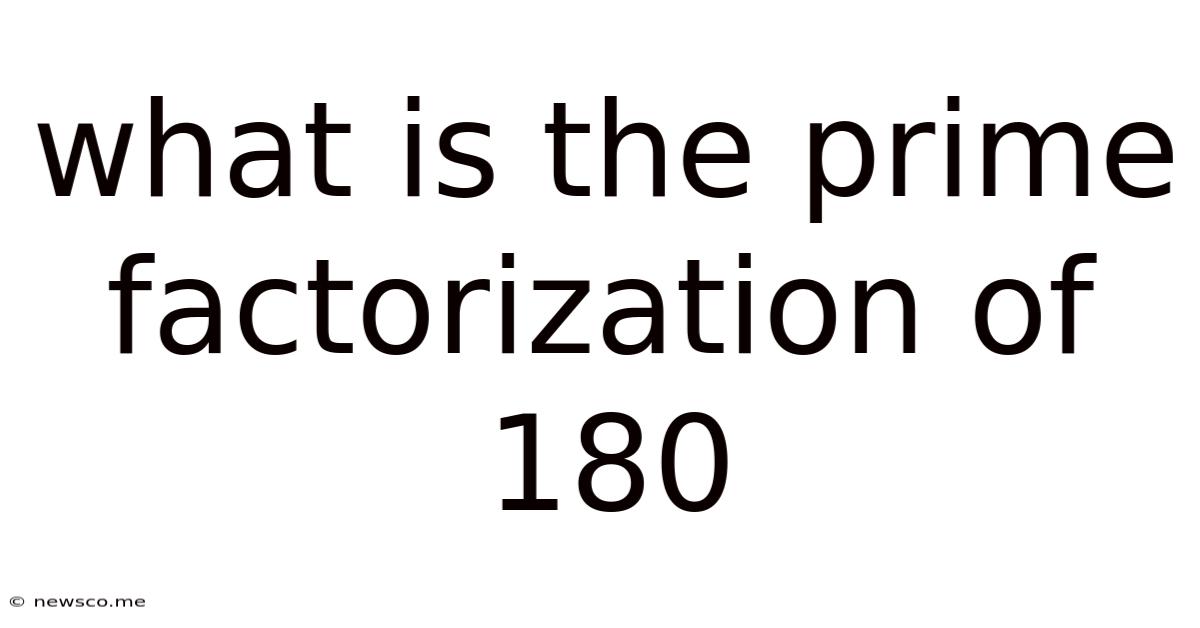What Is The Prime Factorization Of 180
News Co
Apr 22, 2025 · 5 min read

Table of Contents
What is the Prime Factorization of 180? A Deep Dive into Prime Numbers and Factorization
Finding the prime factorization of a number might seem like a simple mathematical exercise, but it's a fundamental concept with wide-ranging applications in number theory, cryptography, and computer science. This article will explore the prime factorization of 180, providing a step-by-step guide and delving deeper into the underlying principles. We'll also touch upon the importance of prime factorization and its real-world applications.
Understanding Prime Numbers and Factorization
Before diving into the prime factorization of 180, let's establish a strong foundation.
What are Prime Numbers?
A prime number is a natural number greater than 1 that has no positive divisors other than 1 and itself. In simpler terms, it's only divisible by 1 and itself. The first few prime numbers are 2, 3, 5, 7, 11, 13, and so on. Note that 1 is not considered a prime number.
What is Factorization?
Factorization is the process of breaking down a composite number (a number that is not prime) into its prime factors. These prime factors are the building blocks of the composite number, much like atoms are the building blocks of molecules. Every composite number can be uniquely expressed as a product of prime numbers. This is known as the Fundamental Theorem of Arithmetic.
Finding the Prime Factorization of 180: A Step-by-Step Approach
Now, let's find the prime factorization of 180 using a common method: the factor tree.
-
Start with the number: We begin with the number 180.
-
Find a prime factor: The smallest prime number is 2. Since 180 is an even number, it's divisible by 2. 180 divided by 2 is 90. We represent this in our factor tree:
180 / \ 2 90 -
Continue factoring: Now we focus on 90. 90 is also divisible by 2 (it's even), resulting in 45:
180 / \ 2 90 / \ 2 45 -
Move to the next prime: 45 is not divisible by 2, but it is divisible by 3 (45/3 = 15).
180 / \ 2 90 / \ 2 45 / \ 3 15 -
Keep going: 15 is also divisible by 3 (15/3 = 5).
180 / \ 2 90 / \ 2 45 / \ 3 15 / \ 3 5 -
We've reached prime numbers: We've reached the end of our factor tree because 3 and 5 are both prime numbers. They cannot be factored further.
-
The prime factorization: The prime factorization of 180 is the product of all the prime numbers at the bottom of our tree: 2 x 2 x 3 x 3 x 5. This can be written more concisely as 2² x 3² x 5.
Therefore, the prime factorization of 180 is 2² x 3² x 5.
Alternative Methods for Prime Factorization
While the factor tree is a visually intuitive method, other techniques can also be used:
-
Division method: Repeatedly divide the number by the smallest prime number that divides it evenly until you reach 1. Keep track of the prime divisors used. This method is often more efficient for larger numbers.
-
Using a prime factorization calculator: For very large numbers, online calculators or software can quickly determine the prime factorization. However, understanding the underlying process is crucial for grasping the mathematical concepts.
The Significance of Prime Factorization
The seemingly simple task of prime factorization has far-reaching consequences in various fields:
Cryptography
Prime factorization is at the heart of many modern encryption algorithms. RSA encryption, widely used to secure online transactions, relies on the difficulty of factoring very large numbers into their prime factors. The larger the numbers, the more computationally expensive the factorization becomes, ensuring data security.
Number Theory
Prime factorization is a cornerstone of number theory, a branch of mathematics focused on the properties of integers. Many theorems and conjectures in number theory depend on the prime factorization of numbers.
Computer Science
Prime factorization algorithms are used in various areas of computer science, including:
-
Hashing: Algorithms that use prime numbers for creating hash tables often offer better performance and avoid collisions.
-
Random number generation: Prime numbers play a role in designing efficient and robust random number generators.
-
Data structures: Some data structures, like hash tables, leverage the properties of prime numbers for optimization.
Applications of Prime Factorization in Real-World Scenarios
Beyond the theoretical realm, prime factorization has practical applications:
-
Cryptography in E-commerce: When you make an online purchase, prime factorization ensures the security of your financial information.
-
Secure communication: The confidentiality of online chats, email, and other communication protocols often relies on encryption techniques based on prime numbers.
-
Digital signatures: Prime numbers are critical in creating and verifying digital signatures, used to authenticate documents and ensure data integrity.
-
Software development: Efficient prime factorization algorithms improve the performance of software applications that handle large datasets or perform complex calculations.
Conclusion
The prime factorization of 180, 2² x 3² x 5, is more than just a mathematical result. It represents a fundamental concept in number theory with significant implications across multiple disciplines. Understanding prime numbers and factorization is not only crucial for academic pursuits but also for appreciating the security and functionality of many technologies we rely on daily. From securing online transactions to developing efficient software, the seemingly simple act of breaking down a number into its prime factors has profound and far-reaching consequences. This exploration of the prime factorization of 180 serves as a stepping stone to a deeper understanding of this essential mathematical concept.
Latest Posts
Related Post
Thank you for visiting our website which covers about What Is The Prime Factorization Of 180 . We hope the information provided has been useful to you. Feel free to contact us if you have any questions or need further assistance. See you next time and don't miss to bookmark.